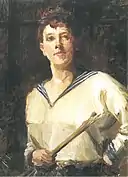Marianne von Werefkin
Marianne von Werefkin, born Marianna Wladimirowna Werewkina (Russian: Мариа́нна Влади́мировна Верёвкина, tr. Mariánna Vladímirovna Verëvkina, IPA: [mərʲɪˈanːə vlɐˈdʲimʲɪrəvnə vʲɪˈrʲɵfkʲɪnə]; 10 September [O.S. 29 August] 1860 – 6 February 1938), was a Russian-German-Swiss Expressionist painter.
Marianne von Werefkin | |
|---|---|
 Self portrait, circa 1910 | |
| Born | Marianna Wladimirowna Werewkina 10 September 1860 |
| Died | 6 February 1938 (aged 77) |
| Known for | painting |
| Movement | Expressionism |
Life and career
Marianne von Werefkin was born in the Russian town of Tula as the daughter of the commander of the Ekaterinaburg Regiment. She had her first private academic drawing lessons at the age of fourteen. In 1880, she became a student of Ilya Repin, the most important painter of Russian Realism. Her progress was dealt a setback by a hunting accident in 1888 in which she accidentally shot her right hand which remained crippled after a lengthy period of recovery. By practicing persistently she finally managed to use drawing and painting instruments with her right hand again.
In 1892 she met Alexej von Jawlensky, who desired to be her protégé, and in 1896 she, Jawlensky, and their servant moved to Munich. Werefkin studied with other Russians in Munich at an art school directed by the Slovenian Anton Ažbè.[1]
For the sake of Jawlensky's painting, Werefkin interrupted her painting for almost ten years.
She began painting again in 1906. In 1907 she created her first expressionist works; in these she followed Paul Gauguin's and Louis Anquetin's style of "surface painting", while also showing the influence of Edvard Munch. She and Jawlensky spent in 1908 several periods working with Kandinsky and Münter after their discovery of the picturesque rural town of Murnau near Munich, where Gabriele Münter owned a house. The four artists frequently painted together in open air in and around Murnau.
At her Munich apartment, Werefkin initiated a Salon which soon became a center of lively artistic exchange between members of the German and Russian avant-garde who would later be founders of the Neue Künstlervereinigung München (New Association of Artists in Munich, NKVM) and Blaue Reiter.[1] The NKVM, founded in 1909, became a forum of exhibitions and programming. At the first touring exhibition of NKVM, Werefkin exhibited Washerwomen (1909) and The Storm (1907). The simplified form and psychological content of works relate to the sources Werefkin admired at this time including the artist Paul Gauguin, Japanese woodcuts and the expressive works of the Nabis in France.[2]
Werefkin also founded the “Lukasbruderschaft” of which also Kandinsky was a member.[3]
The two principals of Blaue Reiter, Kandinsky and Marc, met each other at Werefkin and Jawlensky's home on New Year's Eve in 1911.[1] After a few years Wassily Kandinsky and Franz Marc distanced themselves from NKVM and formed Der Blaue Reiter (Blue Rider). The group was founded by a number of Russian emigrants, including Wassily Kandinsky, Alexej von Jawlensky and a number of native German artists, such as Franz Marc, August Macke and Gabriele Münter. Werefkin began exhibiting together with Blaue Reiter in 1913.
At the outbreak of the First World War, Werefkin and Jawlensky immigrated to Switzerland, near Geneva. They later moved to Zurich. By 1918, they had separated, and Werefkin moved alone to Ascona, on Lago Maggiore where she painted many colorful, landscapes in an expressionist style. In 1924 she founded the artist group "Großer Bär" (i.e., Big Bear, Ursa Major).
In her later years, she painted posters. Her friends "Carmen" and "Diego Hagmann" protected her from poverty.
Marianne von Werefkin died in Ascona on 6 February 1938. She was buried in the Russian graveyard in Ascona.
Gallery of paintings
 Selfportrait in sailor blouse, 1893, oil on canvas
Selfportrait in sailor blouse, 1893, oil on canvas In the Theater I, 1906, tempera and gouache on paper
In the Theater I, 1906, tempera and gouache on paper%252C_1907.jpg.webp) Fall, School (Herbst, Schule), c. 1907, tempera on cardboard
Fall, School (Herbst, Schule), c. 1907, tempera on cardboard.jpg.webp) The Black Women (Schwarze Frauen), 1910, gouache on cardboard
The Black Women (Schwarze Frauen), 1910, gouache on cardboard Ice Skaters (I pattinatori), 1911, tempera-painting on paper
Ice Skaters (I pattinatori), 1911, tempera-painting on paper Storm Winds (Sturmwind), 1915–17, oil on canvas
Storm Winds (Sturmwind), 1915–17, oil on canvas Police sentinel in Vilnius, 1917, tempera on canvas, Museo Comunale d'Arte Moderna, Ascona
Police sentinel in Vilnius, 1917, tempera on canvas, Museo Comunale d'Arte Moderna, Ascona.jpg.webp) Fantastic Night, 1917, oil and tempera on cardboard
Fantastic Night, 1917, oil and tempera on cardboard The Family (La Familia), 1922, tempera on cardboard
The Family (La Familia), 1922, tempera on cardboard The Monk (Der Mönch), 1932, tempera on cardboard
The Monk (Der Mönch), 1932, tempera on cardboard
See also
References
Quoted from: "Marianne von Werefkin in Murnau - Kunst und Theorie, Vorbilder und Künstlerfreunde", Katalog einer Sonderausstellung im Schloßmuseum Murnau, bearbeitet von Brigitte Salmen.
- Barnett, Vivian Endicott. “Russian Artists in Munich and the Russian Participation in Der Blaue Reiter.” In Russian Modernism: Cross Currents of German and Russian Art, 1907-1917, 61–74. Edited by Konstantin Akinsha. Munich, London, New York: Prestel, 2015.
- "Marianne von Werefkin Wäscherinnen". Lenbachhaus Sammlung Online. Retrieved 27 September 2019.
- Roßbeck, Brigitte (2014). Marianne von Werefkin: Die Russin aus dem Kreis des Blauen Reiters. Siedler Verlag. ISBN 9783641156046.
External links
| Wikiquote has quotations related to: Marianne von Werefkin |
| Wikimedia Commons has media related to Marianne von Werefkin. |
- A short biography, with a photo
- Marianne von Werefkin at Bohusläns museum, Uddevalla, Sweden (in Swedish)
Further reading
- Malycheva, Tanja, and Isabel Wünsche, editors. Marianne Werefkin and the Women Artists in Her Circle. Brill, 2017 ISBN 978-90-04-32897-6
